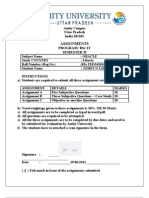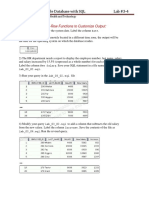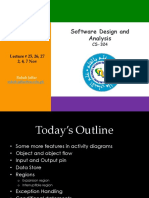SQL Lab 2 Exercises
Uploaded by
NehaSQL Lab 2 Exercises
Uploaded by
NehaLAB-2 EXERCISES
Functions and Date Time
1. Write An SQL Query To Print Details Of The Workers Who Have Joined In Feb’2014.
2. Write An SQL Query To Show Only Odd Rows From A Table.
3. List the employees whose salary is more than 3000 after giving 20% increment.
4. Write a SQL statement that counts all employees hiring on date August 17th, 2012.
5. Write a query to find the details of those employees who contain eight or more characters
in their first name.
6. Write a query to get the employee id, email id to discard the last three characters.
7. Write a query to find all the employees which first name contains the entire uppercase
letter.
8. Write a query which returns a date after which a certain time/date interval has been
subtracted.
9. Convert a date which is in the character string to a date value.
10. Write a query which returns employees whose last names begin with the letter L, whose
ASCII equivalent is 76:
You might also like
- Apache Cassandra Administrator Associate - Exam Practice TestsFrom EverandApache Cassandra Administrator Associate - Exam Practice TestsNo ratings yet
- SQL Exercises, Practice, Solution - Exercises On Employee DatabaseNo ratings yetSQL Exercises, Practice, Solution - Exercises On Employee Database9 pages
- Lab-Iv Unix and Shell Programming Laboratory (CSE-224: PrerequisitesNo ratings yetLab-Iv Unix and Shell Programming Laboratory (CSE-224: Prerequisites2 pages
- Lesson 2 - Exploring Linux Command-Line Tools - Part 2 - 2-Đã M KhóaNo ratings yetLesson 2 - Exploring Linux Command-Line Tools - Part 2 - 2-Đã M Khóa5 pages
- Lecture 01 - Introduction To DBMS, MS AccessNo ratings yetLecture 01 - Introduction To DBMS, MS Access11 pages
- Advanced Database Management System - Tutorials and Notes - Partitioned Parallel Hash JoinNo ratings yetAdvanced Database Management System - Tutorials and Notes - Partitioned Parallel Hash Join6 pages
- Entity Relationship Diagram: Lecturer: Hesham Gamal GaafarNo ratings yetEntity Relationship Diagram: Lecturer: Hesham Gamal Gaafar37 pages
- Data Definition Language (DDL) Commands: Sql-Lab 1No ratings yetData Definition Language (DDL) Commands: Sql-Lab 15 pages
- Expanded Pine Valley Furniture Company Database: Background100% (1)Expanded Pine Valley Furniture Company Database: Background31 pages
- Lab # 06 Implementation of SQL ConstraintsNo ratings yetLab # 06 Implementation of SQL Constraints21 pages
- Lab Exam Question Paper - Web Programming Tech - Batch 2,3,4No ratings yetLab Exam Question Paper - Web Programming Tech - Batch 2,3,43 pages
- Arid Agriculture University, Rawalpindi: Final Exam / Fall 2020 (Paper Duration 24 Hours) To Be Filled by TeacherNo ratings yetArid Agriculture University, Rawalpindi: Final Exam / Fall 2020 (Paper Duration 24 Hours) To Be Filled by Teacher10 pages
- Python Exercises Documentation: Release 1.0No ratings yetPython Exercises Documentation: Release 1.015 pages
- 1 CS205 - DATA - STRUCTURES - QP MAIN JAN 2017 - Ktu Qbank100% (1)1 CS205 - DATA - STRUCTURES - QP MAIN JAN 2017 - Ktu Qbank3 pages
- CS326 Parallel and Distributed Computing: SPRING 2021 National University of Computer and Emerging SciencesNo ratings yetCS326 Parallel and Distributed Computing: SPRING 2021 National University of Computer and Emerging Sciences33 pages
- CS481 - Data Science: Muhammad Sohail AfzalNo ratings yetCS481 - Data Science: Muhammad Sohail Afzal31 pages
- CS326 Parallel and Distributed Computing: SPRING 2021 National University of Computer and Emerging SciencesNo ratings yetCS326 Parallel and Distributed Computing: SPRING 2021 National University of Computer and Emerging Sciences47 pages
- Software Design and Analysis: State Transition DiagramNo ratings yetSoftware Design and Analysis: State Transition Diagram51 pages
- Sub Queries and Groups of Data: Lab Manual 04No ratings yetSub Queries and Groups of Data: Lab Manual 0412 pages
- Database Systems: Lab 08 PL SQL (Continue)No ratings yetDatabase Systems: Lab 08 PL SQL (Continue)30 pages
- Functions, Operators, Date - Time Lab Manual: Dummy X Select 777 888 From DualNo ratings yetFunctions, Operators, Date - Time Lab Manual: Dummy X Select 777 888 From Dual17 pages
- Lab Manual 05 Intro - Kernel Configuration PDFNo ratings yetLab Manual 05 Intro - Kernel Configuration PDF8 pages





















































































